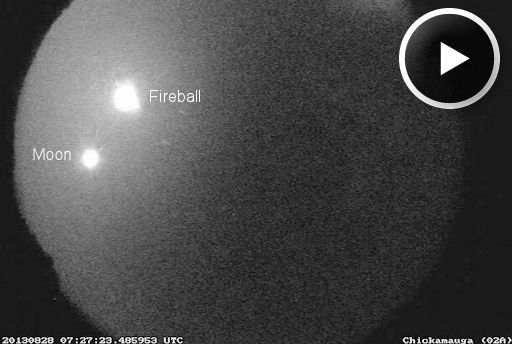INCOMING CME: A coronal mass ejection (CME, movie) is expected to hit Earth's magnetic field on Sept. 1st, sparking minor to moderate geomagnetic storms around the poles. The CME was propelled toward Earth by a C8-class flare from sunspot AR1836 on August 30th. High-latitude sky watchers, be alert for auroras! Aurora alerts: text, voice.
MAJOR FIREBALL EVENT, UPGRADED (AGAIN): NASA's Meteoroid Environment Office has upgraded its estimates of a major fireball that exploded over the southeastern USA around 2:30 AM on August 28th. Lead researcher Bill Cooke says "the fireball reached a peak apparent magnitude of -16, about 20 times brighter than a Full Moon, and cast shadows on the ground. This indicates that the meteoroid had a mass of more than 110 kg (240 lbs) and was up to a meter in diameter. It hit the top of Earth's atmosphere traveling 25 km/s (56,000 mph)." Watch the movie, then read more about the fireball below:
"This is the brightest event our network has observed in 5 years of operation," he continues. "There are reports of sonic booms reaching the ground, and data from 4 doppler radars indicate that some meteorites may have fallen along the fireball's ground track." (Note: The city in the ground track map is Cleveland, Tennessee, not Cleveland, Ohio.)
An initial calculation of the fireball's orbit suggested it might be a fragment from a Jupiter family comet. Improved estimates of the orbital parameters point to a different kind of object: a main belt asteroid. If meteorites are recovered from the Tennessee countryside, their chemical composition will tell researchers more about the origin of the fireball.

Solar wind
speed: 408.6 km/sec
density: 3.3 protons/cm3
explanation | more data
Updated: Today at 1507 UT
X-ray Solar Flares
6-hr max: B7 0940 UT Aug31
24-hr: B7 0940 UT Aug31
explanation | more data
Updated: Today at: 1500 UT
![]()
Daily Sun: 31 Aug 13
Sunspot AR1836 poses a threat for M-class solar flares. Credit: SDO/HMI
![]()
Sunspot number: 62
What is the sunspot number?
Updated 31 Aug 2013
Spotless Days
Current Stretch: 0 days
2013 total: 0 days (0%)
2012 total: 0 days (0%)
2011 total: 2 days (<1%)
2010 total: 51 days (14%)
2009 total: 260 days (71%)
Since 2004: 821 days
Typical Solar Min: 486 days
Update 31 Aug 2013
The Radio Sun
10.7 cm flux: 108 sfu
explanation | more data
Updated 31 Aug 2013
![]()
Current Auroral Oval:
Switch to: Europe, USA, New Zealand, Antarctica
Credit: NOAA/POES
![]()
Planetary K-index
Now: Kp= 2 quiet
24-hr max: Kp= 4 unsettled
explanation | more data
Interplanetary Mag. Field
Btotal: 4.2 nT
Bz: 0.9 nT south
explanation | more data
Updated: Today at 1507 UT
![]()
Coronal Holes: 31 Aug 13
Solar wind flowing from the indicated coronal hole should reach Earth on Aug. 31-Sept. 1. Credit: SDO/AIA.





